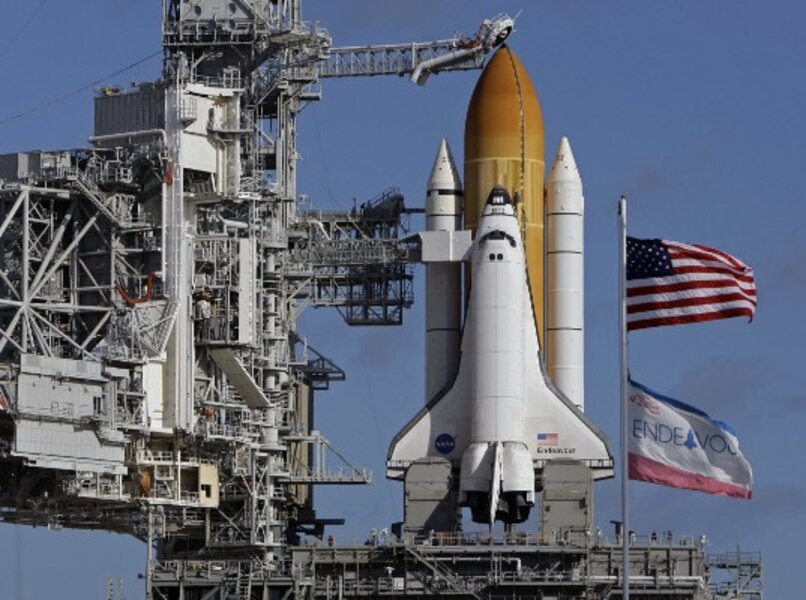Endeavour to deliver Space Station 'a room with a view'
Loading...
After years of construction, the International Space Station is about to get a room with a spectacular view.
At 4:39 a.m. Eastern Standard Time Sunday, NASA is set to launch the space shuttle Endeavour and its six-member crew on a mission to deliver the final US components – made in Europe – to the orbiting lab: Node 3, named Tranquility, and a seven-window cupola for the node, which will give crewmembers breathtaking views of Earth and space.
Much of the module will act as the station's utility room, housing equipment that reprocesses urine to extract drinking water, scrubs carbon dioxide from the station's air, and process other crew waste. It also will become the final home for exercise equipment, including COLBERT, the exercise station whose acronym is a nod to Stephen Colbert, host of the Colbert Report on Comedy Central.
Astronauts will make three space walks
During three spacewalks, the shuttle crew will install the node, connect it to the station's cooling system, and install the cupola. Astronauts also are looking to help repair the station's balky urine-purification system, as well as deliver supplies.
But the star of the module remains the cupola and its windows. NASA has dubbed it the station's "control tower," allowing crew members inside to help guide spacewalks and robotic-arm activities outside. But for crewmembers on orbit, it also carries a significant quality-of-life aspect, managers acknowledge.
Much of the time, the windows' protective covers will be closed to avoid damage from space junk or micrometeoroids. In addition, the shutters help keep the windows out of direct sunlight, where constant cycling between heat and cold would weaken their seals.
But the cupola, mounted on the earthward side of Tranquility, can be used for smell-the-roses moments or as the view to exercise, particularly the windows looking straight down or toward the trailing segments of the station, where orbital-debris strikes are far less likely.
Installing and activated the cupola is one of the mission's high points – even for the shuttle crew. Crew members won't be able to open the windows' protective shutters until late in the mission. But when that happens, it will be an oooh-and-ah moment. It will give station crew members the kind of view usually reserved for spacewalkers.
"We will definitely be bringing along some still cameras as well as video cameras to try to capture those views as best we can," says mission specialist Kathryn Hire. "But I can guarantee you, we can provide high-definition pictures, but it's still not like the real thing – being there and having the full expanse laid out in front of you."
Budget crunch for NASA?
The launch comes at a time of heightened angst within NASA.
Last week the Obama administration sent to Congress a budget that cancels the Constellation program. The program not only was well along in developing a replacement for the shuttle to ferry crews to the space station. Over the long term, it aimed to provide a more powerful rocket to carry crew or cargo to destinations more distant than the station's home in low-Earth orbit, initially to the moon.
But the administration's budget proposal – which envisions the agency's budget growing by $6 billion over the next five years – cancels Constellation in favor of launch cargo and astronauts to the station in rockets built by companies with private, rather than federal dollars. Instead the agency would focus on developing technologies that would lead to so-called heavy-lift rockets that would allow for human missions beyond low-Earth orbit.
The budget plan also extends US participation in the station out to 2020, five years longer than the Constellation program envisioned.
Despite the uncertainty, mission managers say their team remains focused on the success of this flight.
"There are a few folks reeling from the shock," acknowledged Michael Moses, the shuttle payload integration manager, during a pre-launch briefing on Friday. But, he added, "the team here is very focused on this mission…. If we can't do what we're doing on Sunday right, then there really is no future for any of the spaceflight programs or the ISS. So we've got to get this launch done."
The launch is the final night launch in the shuttle program, which has four flights left on the schedule after this one. Weather permitting, the orbiter's rise should be visible along the East Coast until main-engine cutoff roughly eight minutes after launch.
-----
Follow us on Twitter.





